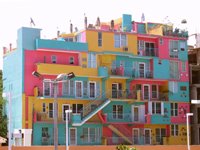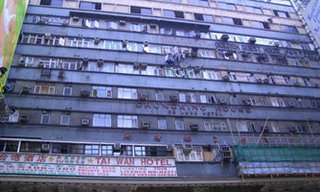
Everyone in Hong Kong dreams of living in a private villa, however, in Puerto Rico, single family houses are cheaper than high-rise apartments. High-rise can easily maintain a higher quality of facilities management. Most importantly, those high-rise mansions are built along the beaches (the coastline). They have plenty of lands but a good view facing Caribbean Sea or Pacific Ocean is limited.
Most old buildings in Puerto Rico are in Spanish style. Three-story building with colonnaded façade, small central courtyard with fountain occasionally, French balcony and wrought iron bars, stucco finishes and colorful paints, cobblestone streets … the first glance to the streetscape of Old San Juan reminds me of Macau.
For those modern buildings, I can see many Corbusian followers. The descendants of Villa Savoye and Maison Citrohan are everywhere. Besides, the major design features are big balcony and elaborated façade treatment. They seriously consider the orientation of buildings and articulate the four facades with different shading devices. Some of them, I think, are too overwhelming that they have gone beyond their practical aims. However, they all look beautiful.
Every time I mentioned shading devices, I would think of Brian Sullivan!
Image is an interesting casa in San Juan.
 Everyone in Hong Kong dreams of living in a private villa, however, in Puerto Rico, single family houses are cheaper than high-rise apartments. High-rise can easily maintain a higher quality of facilities management. Most importantly, those high-rise mansions are built along the beaches (the coastline). They have plenty of lands but a good view facing Caribbean Sea or Pacific Ocean is limited.
Most old buildings in Puerto Rico are in Spanish style. Three-story building with colonnaded façade, small central courtyard with fountain occasionally, French balcony and wrought iron bars, stucco finishes and colorful paints, cobblestone streets … the first glance to the streetscape of Old San Juan reminds me of Macau.
For those modern buildings, I can see many Corbusian followers. The descendants of Villa Savoye and Maison Citrohan are everywhere. Besides, the major design features are big balcony and elaborated façade treatment. They seriously consider the orientation of buildings and articulate the four facades with different shading devices. Some of them, I think, are too overwhelming that they have gone beyond their practical aims. However, they all look beautiful.
Every time I mentioned shading devices, I would think of Brian Sullivan!
Image is an interesting casa in San Juan.
Everyone in Hong Kong dreams of living in a private villa, however, in Puerto Rico, single family houses are cheaper than high-rise apartments. High-rise can easily maintain a higher quality of facilities management. Most importantly, those high-rise mansions are built along the beaches (the coastline). They have plenty of lands but a good view facing Caribbean Sea or Pacific Ocean is limited.
Most old buildings in Puerto Rico are in Spanish style. Three-story building with colonnaded façade, small central courtyard with fountain occasionally, French balcony and wrought iron bars, stucco finishes and colorful paints, cobblestone streets … the first glance to the streetscape of Old San Juan reminds me of Macau.
For those modern buildings, I can see many Corbusian followers. The descendants of Villa Savoye and Maison Citrohan are everywhere. Besides, the major design features are big balcony and elaborated façade treatment. They seriously consider the orientation of buildings and articulate the four facades with different shading devices. Some of them, I think, are too overwhelming that they have gone beyond their practical aims. However, they all look beautiful.
Every time I mentioned shading devices, I would think of Brian Sullivan!
Image is an interesting casa in San Juan.





